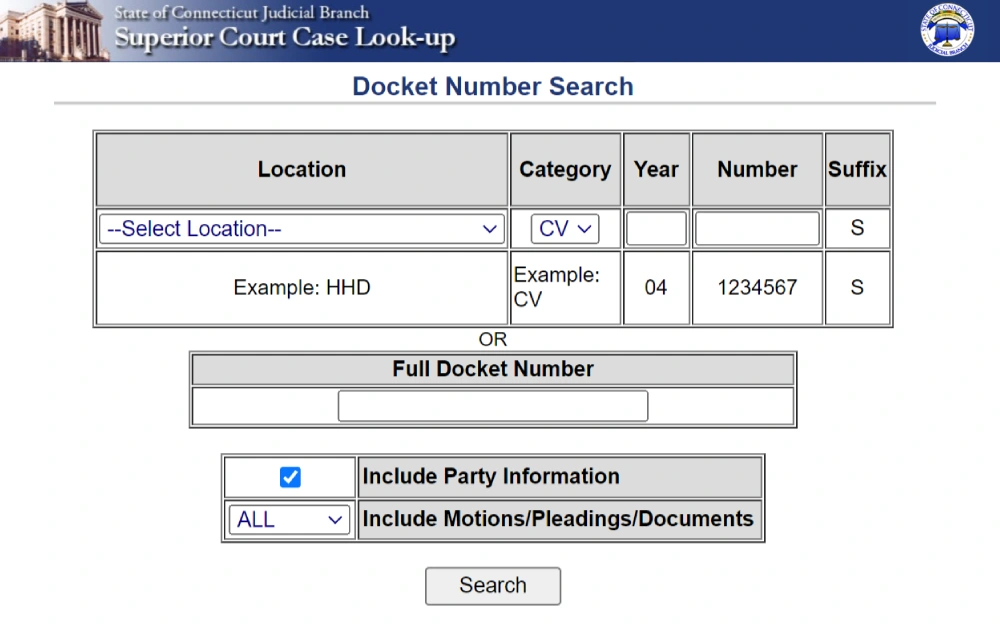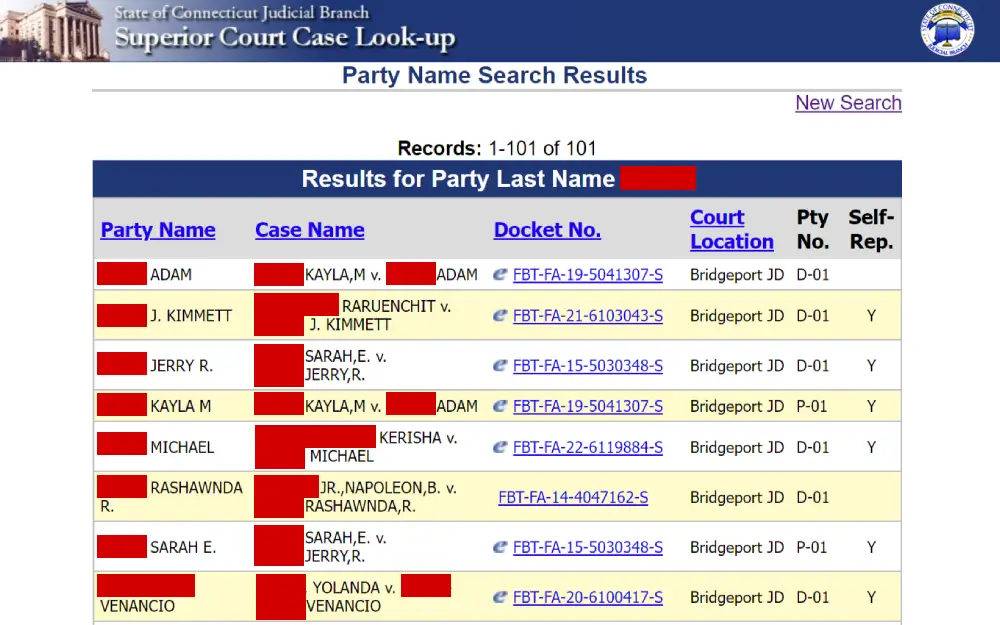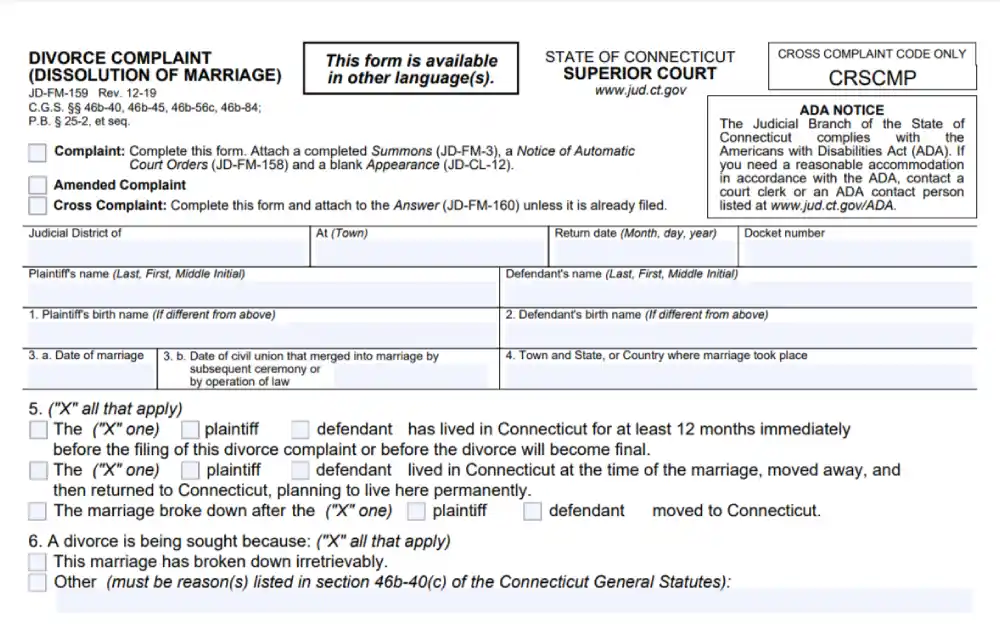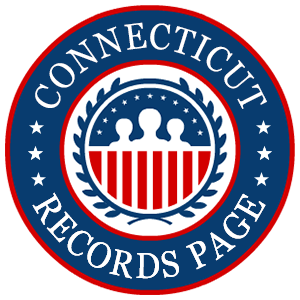Find free Connecticut divorce records in just minutes; the information they provide can be used for various reasons.
For instance, divorce records can be used as part of a genealogy search to learn more about one’s family heritage. You may also access divorce records if you are just curious about the marital history of a person you know.
The Connecticut Freedom of Information Act provides the right to access divorce records. This law authorizes government agencies to make this information available to the public for inspection. While citizens have a right to access this information, there is no uniform process for requesting it.
Also, the law has various exceptions that may restrict access. This article will walk you through the steps a record seeker needs to take to access both new and archived divorce records. Use the tools below to perform a free search of divorce records throughout Connecticut.
This resource was written by Attorney Robert Bailey Jr, who holds a Juris Doctorate from Widener University School of Law.
The Availability of Divorce Records in Connecticut
Divorce information is considered a public record in Connecticut. The Connecticut Freedom of Information Act authorizes county and state agencies to provide individuals with access to this information.1 These divorce records are available with multiple custodians, depending on whether you are looking for archived or more recent filings.
While this information is generally available, there are some limitations. For instance, section 25-59A (h) of the Connecticut Practice Book requires that certain financial information (e.g., current income, expenses etc.) be withheld from the public.2 Sometimes, the court makes the decision on a case-by-case basis to seal other aspects of a divorce record.
This may include, for example, sensitive information about minors or victims of abuse. In some states, certain orders from the court, such as the decree, are restricted to a particular set of eligible people.
In other states, they will distinguish between who can access certified divorce records as opposed to informational copies. Certified copies are typically used for business and legal reasons, such as insurance claims and name changes.
Connecticut does not have these restrictions and allows anyone to access these records. Connecticut even has a process that allows individuals to request a court transcript from a specific divorce hearing.3 Keep in mind, redactions may be made consistent with any exemptions under the Connecticut Freedom of Information Act and other state laws.
Divorce records are not the only thing citizens can access related to this subject. There is also statewide divorce data that can provide insight into this topic.
For instance, you can get data on the divorce rate in Connecticut through the Centers for Disease Control and Prevention’s National Center for Health Statistics.4 The current rate in Connecticut is 2.5 divorces per 1,000 people, which is consistent with the national average for the United States.

How To Check Connecticut Divorce Records for Free
If a citizen is looking for a way to access divorce records in CT, they can do so with the Superior Court’s Case Look-Up Tool.5 The Connecticut Superior Court is responsible for adjudicating all divorce and other types of family law cases.
To begin an online search, select whether you want to look up a divorce record by party name, docket number or the attorney (or law firm) that represented someone. If you have the docket number, you can enter that information and go directly to the case.

If not, you can follow the steps below to perform a targeted name-based search for a divorce record.
- Under the “Case Category” drop-down menu, select “FA” for family.
- Under the “Case Type” drop-down menu, select “Dissolution of Marriage” or any other relevant type of dissolution you are looking to access.
- If you know where the divorce occurred, you can narrow down the results by selecting the specific judicial district.
- Enter the party’s last and first name. If you are unsure about the person’s complete name, you can adjust the “Name Search Type” in various helpful ways.
Note: There are other options available if you want to look up an individual’s legal separation or the dissolution of a civil union. In addition, you can look up an annulment. An annulment is when the court determines that a marriage was never valid in the first place due to some state requirement (e.g., age of consent, familial relationship, mental incompetence).
Once you click search, you will get a list of matching results. The results will provide a party’s name, case caption, docket number and court location. To get the complete online divorce record, a record seeker can click on the docket number.

When you open the record, you can view information on the disposition of the case (i.e., how the matter was resolved) and the date it was resolved. The online divorce record will also provide the party’s appearances, along with either the attorney’s information or an indication that the party chose to represent themselves.
There is also a section that provides upcoming scheduled court dates. This is a great tool if you are viewing a divorce case that is still active. Here, you can see the date, time and a brief description of the next court hearing.
To get a chronological order of all case events, you can go to the Motions and Pleadings section. Here, a citizen can view everything that occurred in a case from the initial filing of the complaint to when the judgment of dissolution was entered. However, the actual documents and court orders can not be viewed online.
To access this information, a person will have to go to the Clerk’s Office in the Judicial District where the case was tried. In some states, there is a centralized option for obtaining an official document that certifies a person’s divorce (usually referred to as a divorce certificate).
Oftentimes, this certificate is provided by the state’s vital records or similar department. In Connecticut, this option is not available, and a person will have to request the divorce decree (referred to as a Judgment File in Connecticut from the Superior Court where the divorce was filed.
Later in this article, information will be provided on how to search for divorce records at the county level, as well as the process for looking up archived dissolution records.
Using County Agencies in CT to Search for Divorce Records
State-level searches are broader in nature, but they are not your only option for accessing divorce records in Connecticut. Searching at the county level may provide an individual with the information quicker than if requested through statewide options. In addition, you may have easier access to talk to someone or go in person if you are making the request through a county-run agency.
These are just a couple of examples, and you may have other reasons for searching at the county level. To assist with accessing divorce records more locally, we have provided information one can use for obtaining divorce records in the four most populated counties in Connecticut.
The largest county in Connecticut is Fairfield County. If a citizen wants to look for divorce records here, they can make a request with the Clerk of the Fairfield Judicial District. As the record custodian, they can provide access to public divorce records in the county.
The Clerk’s Office is open Monday through Friday from 9:00 AM to 5:00 PM, and they can be contacted by phone at 203-579-6527. To talk to someone in person, you can go to the address below:
Fairfield Judicial District
1061 Main St.
Bridgeport, Connecticut 06604
Hartford County is the second largest county in Connecticut. If you want to access divorce records in this county, you will have to make a request with the Hartford Judicial District Clerk.8 Their office is open from 9:00 AM to 5:00 PM, Monday through Friday.
If you want to talk to someone about the process for searching or accessing divorce records, you can call them at 860-548-2700. You can also talk to someone at the Clerk’s Office, which is located at the address below:
Hartford Judicial District
95 Washington St.
Hartford, Connecticut 06106
New Haven County has the third highest population of all the counties in Connecticut. If you want to request divorce records at the county level, you can inquire with the New Haven Judicial District Clerk.9 As record custodians, their office can provide an individual with the process for both searching and requesting divorce records.
To get information on accessing New Haven County divorce records, call their office at 203-503-6800. The Clerk’s Office is open Monday through Friday, from 9:00 AM to 5:00 PM. The Clerk’s Office is located at the address below:
New Haven Judicial District
235 Church St.
New Haven, Connecticut 06510
The fourth largest county in Connecticut is New London County. For information on how to access divorce records, reach out to the Clerk of the New London County Judicial District. They are located at the address below:
New London Judicial District
70 Huntington St.
New London, Connecticut 06320
If you want to ask specific questions about the process for accessing divorce records, you can also contact them by phone at 860-443-5363. They are open from 9:00 AM to 5:00 PM, Monday through Friday.
Reminder: Limited online records can be searched by county using the Case Look-Up Tool provided by the Connecticut Superior Court. However, complete records can only be accessed by using the information provided above.
Finding Free Divorce Archives in Connecticut for Genealogy Purposes
For individuals who are trying to learn more about their family history they may want to perform a free public divorce records search for archived information. Accessing archived divorce records is not the same as finding more recent filings. The older the record, the more likely you will have to use various resources to find the information.
The Connecticut State Library provides access to archived divorce records for genealogy research. A review of their summary of sources can point you in the direction of where to look, depending on the age of the archived divorce records you are seeking.10
A researcher who has questions about procedures for access and copies of these records can contact the Connecticut State Library by phone at 860-566-3692. You can also review their Archived Records Guide to assist you with your search.11
The library also provides detailed information as to where to find archived divorce records by each Connecticut county. They also provide various divorce indexes and digitized records for a citizen to view.12, 13 The Connecticut State Library is open to in-person searches from 10 AM to 2:00 PM, Monday through Friday.
They are located at the address below:
Connecticut State Library
231 Capitol Ave.
Hartford, Connecticut 06106
Another option is to look up archived divorce records through the Connecticut Digital Archive.14 They have various divorce indexes that can provide used information for someone performing a genealogy search.

There are other alternatives to accessing archived divorce records. Consider unique ways to find older documents (e.g., newspapers) that may contain this information. Places where this information may be located include public libraries, religious institutions and historical societies.
How To Review Details About Dissolutions of Marriage in Connecticut
In Connecticut, the legal term for a divorce is the dissolution of marriage. In order to find information on someone’s dissolution of marriage, you can use the same process as locating divorce records.
To look up this information online, you can perform a search using the Connecticut Superior Court’s Case Search Tool. If you need additional information, you will have to contact the Superior Court where the dissolution occurred.
Common law marriage is when a state legally recognizes a couple as married, even though they did not go through the specific steps to obtain a license.15 The general requirement is that the parties had an intent to be married and, in some manner, held themselves out as such. However, common law marriage is not authorized by Connecticut statute.
As a result, there is no such thing as a common law divorce in Connecticut. Since same-sex marriages were legalized in Connecticut in October 2010, there are no longer civil unions.
At this time, all civil unions were converted to marriages. However, if you want to look up the dissolution of past civil unions, you can do so through the same processes as other divorces in the state.
How To Initiate a Divorce in Connecticut & Steps To Take When Served Divorce Papers
If you have come to the decision that you want to end your matrimony and file for divorce, you may be confused as to how to start the process and whether or not you are qualified to file in Connecticut. An individual will also have many questions if they were on the receiving end of divorce papers from their future ex-wife or ex-husband.
If you are contemplating a divorce, it is strongly advised to contact a licensed family law attorney in Connecticut. They will be able to answer questions that are specific to your situation and help you come up with solutions to potential roadblocks. However, the information below can assist you in better understanding the initial steps of the divorce process in Connecticut.
The first step to filing for a divorce in Connecticut is to make sure you meet the residency requirement. If you do not meet this basic requirement, you are unable to file for divorce. In Connecticut, the residency requirement can be met if either you or your spouse has resided in the state for twelve months before the divorce is filed or finalized.
An alternative way to meet the residency requirement is if the marriage became irretrievably broken in Connecticut. The second step before actually filing is to determine the ground for divorce (i.e., the reason why it is justified).
In Connecticut, a person can file for either no-fault or at-fault divorce. At-fault divorce requires evidence of a certain action from one’s spouse, such as adultery or desertion. Most divorces are filed as no-fault, with the basis being that the marriage is irretrievably broken.
There are three primary documents that a person needs to file when initiating a divorce in Connecticut. These documents are the Complaint, Summons and a Notice of Automatic Orders.16 These documents will establish that you meet the necessary requirements for filing for divorce and will provide some basic information about your marriage.

In addition, your complaint will indicate how you want certain matters resolved, such as child support, custody, alimony and the division of assets. These requests can be emotionally charged. Consider finding ways to resolve these matters amicably, such as through mediation and arbitration.
You can also use tools such as a divorce appraisal to take some of the emotion out of the process. If you are responding to a divorce complaint that was filed by your spouse, you have the option to file an Answer.17
The Answer will indicate what aspects of the divorce complaint you agree with and those you disagree with. You can also then submit your own Complaint.
Filing your own Complaint allows you to indicate what you want from the divorce, as well as ensure the divorce proceeding continues, even if your spouse changes their mind. If a person fails to file an answer or complaint, the Judge could enter an order in favor of the party that filed for the divorce.
This information should answer many of the initial questions most people have when contemplating or responding to a request for divorce. In addition, this article contains the necessary resources for accessing both recent and archived Connecticut divorce records.
You can check out the CT marriage record search process or the tutorial on finding all free public information in Connecticut for additional insight into residents of this state.
References
1Connecticut’s Official State. (2021, October 19). Connecticut Freedom of Information Commission: Citizens Guide. Retrieved November 17, 2023, from <https://portal.ct.gov/FOI/Quick-Links/Citizens-Guide>
2State of Connecticut Judicial Branch. (1998). Connecticut Practice Book. Retrieved November 17, 2023, from <https://www.jud.ct.gov/Publications/PracticeBook/PB.pdf>
3Connecticut Judicial Branch. (2022, October). Procedures for Ordering a Court Transcript. Retrieved November 17, 2023, from <https://www.jud.ct.gov/Publications/transcript.pdf>
4Centers for Disease Control and Prevention, National Center for Health Statistics. (2023, February 10). Divorce Rates by State: 2019-2021. Retrieved November 17, 2023, from <https://www.cdc.gov/nchs/pressroom/sosmap/divorce_states/divorce_rates.htm>
5State of Connecticut Judicial Branch. (n.d). Superior Court Case Look-Up. Retrieved November 17, 2023, from <https://civilinquiry.jud.ct.gov/>
6State of Connecticut Judicial Branch. (n.d). Docket Number Search. Retrieved November 17, 2023, from <https://civilinquiry.jud.ct.gov/GetDocket.aspx>
7State of Connecticut Judicial Branch. (n.d). Party Name Search Results. Retrieved November 17, 2023, from <https://civilinquiry.jud.ct.gov/PartySearch.aspx>
8State of Connecticut Judicial Branch. (n.d). Hartford Judicial District. Retrieved November 17, 2023, from <https://jud.ct.gov/directory/directory/directions/26.htm>
9State of Connecticut Judicial Branch. (n.d). New Haven Judicial District. Retrieved November 17, 2023, from <https://jud.ct.gov/directory/directory/directions/30.htm>
10Connecticut State Library. (1989, June). Divorce in Connecticut. Retrieved November 17, 2023, from <https://libguides.ctstatelibrary.org/ld.php?content_id=20512821>
11Connecticut State Library. (2001). Guide to the Records of the Judicial Department. Retrieved November 17, 2023, from <https://ctstatelibrary.org/wp-content/uploads/2019/05/judicial.pdf>
12Connecticut State Library. (2023, November 09). Divorce Indexes. Retrieved November 17, 2023, from <https://libguides.ctstatelibrary.org/hg/divorce/indexes>
13Connecticut State Library. (2023, November 09). Links to Digitized Divorce Records. Retrieved November 17, 2023, from <https://libguides.ctstatelibrary.org/c.php?g=451770&p=10058041>
14Connecticut Digital Archive. (n.d). Divorce Records Search Results. Retrieved November 17, 2023, from <https://archives.lib.uconn.edu/islandora/search?type=dismax&f%5B0%5D=mods_subject_topic_ms%3ADivorce%5C%20records>
15Connecticut General Assembly. (2013, July 02). Common Law Marriage. Retrieved November 17, 2023, from <https://www.cga.ct.gov/2013/rpt/2013-R-0264.htm>
16State of Connecticut Judicial Branch. (2019, December). Divorce Complaint (Dissolution of Marriage). Retrieved November 17, 2023, from <https://www.jud.ct.gov/webforms/forms/fm159.pdf>
17State of Connecticut Judicial Branch. (2014, June). Dissolution Answer. Retrieved November 17, 2023, from <https://www.jud.ct.gov/webforms/forms/fm160.pdf>
